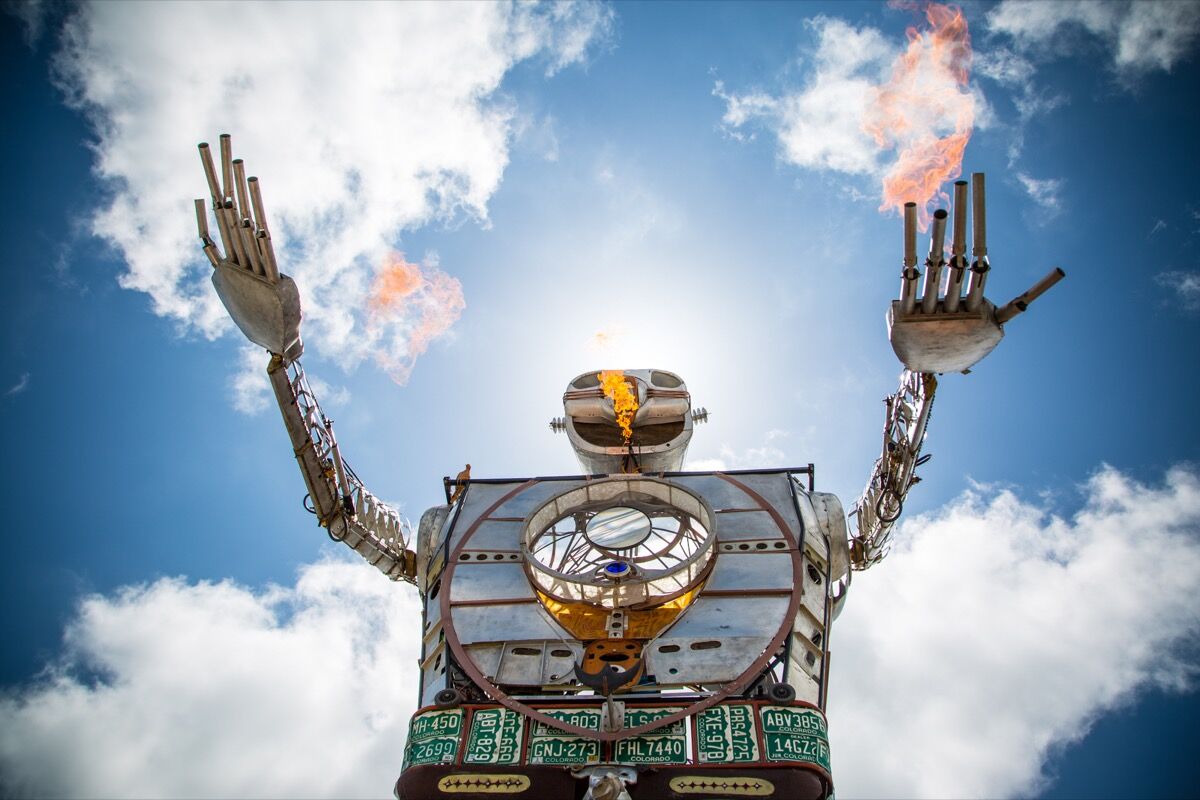
Detail of Shane Evans, Robot Resurrection, 2014m at the Maker Faire, San Francisco. Courtesy of the artist.
#BurningMan #Art #Artists #BlackRockCity #Burners
In late August, some 75,000 people are expected to descend on seven square miles of Nevada desert to build Black Rock City, the annual, temporary home to Burning Man. Within this massive footprint known as the Playa, artists, designers, technologists, and their creative collaborators mount dozens of otherworldly and ambitious art installations—recent years have included everything from a 55-foot-tall steel sculpture of a woman lit by 3,000 LEDs to a group of massive rainbow mushrooms made from corrugated plastic.
A core part of Burning Man culture, which celebrates art, community, and self-expression, these works are feats of creativity, collaboration, technology, and critical thinking. Not just awe-inspiring installations, they become sites for gatherings, meditation, merriment, and relaxation. Then, in the event’s final days, many of the works—including the Man himself—are burned to the ground.
Ahead of Burning Man 2018, where the art theme this year is “I, Robot,” we caught up with the artists behind 15 innovative and inspiring installations, from an 80-foot-tall silver orb to a tribute to the late Burning Man founder Larry Harvey.
Ocean Tunnel
Madeleine Hamann, Mikey Benaron, Sierra Joy, Ryan Searcy, and Chris Olson
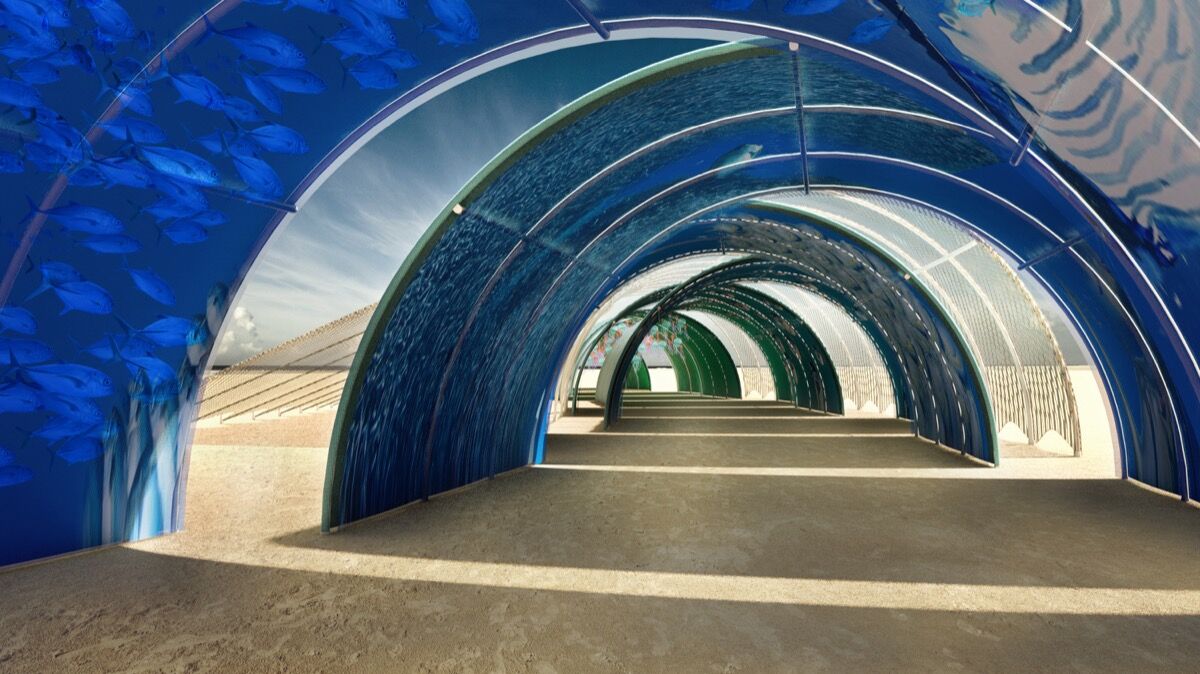
Interior view of Madeleine Hamann, Mikey Benaron, Sierra Joy, Ryan Searcy, and Chris Olson, Ocean Tunnel, 2018. Courtesy of the artists.
Tell us a little bit about Ocean Tunnel.
Ocean Tunnel is a 200-foot-long, 8-foot-tall tunnel filled with murals of marine life. As you pass through, it’s as though you’re taking a journey through time—the murals progress through the history and into the future of open ocean ecosystems that are shifting due to humankind’s far-reaching impact on our planet.
Ocean Tunnel’s lead artist, Madeleine Hamann, is in her final year of graduate study at Scripps Institution of Oceanography. She studies waves, currents, and turbulence in the ocean to push forward our understanding of the ocean’s role in climate change. She works with an incredible team of oceanographers, surfers, divers, and general ocean enthusiasts, including project leads (and seasoned Burners) Casandra Higuera, Mikey Benaron, Chris Olson, Pierce Denham-Zemberi, Paul Chamberlain, and Ryan Searcy.

Ocean Tunnel
View Slideshow
4 Images
The murals are created by different artists from all over: Mark Dugally (Los Angeles),
(Florida), Taylor Reinhold (Santa Cruz, California), Phillip Aurand (Seattle), Sierra Joy and her mother Lynn McGeever (Truckee, California), Isabel Halpern (San Diego), and Lux Meteora (Spain) have all generously donated their time and talents to produce murals for this piece. Many, many more from our community in San Diego have also contributed to the vision and production of the tunnel, and the San Diego Collaborative Arts Project has been instrumental in funding and providing build space and resources. It takes a village!
(Florida), Taylor Reinhold (Santa Cruz, California), Phillip Aurand (Seattle), Sierra Joy and her mother Lynn McGeever (Truckee, California), Isabel Halpern (San Diego), and Lux Meteora (Spain) have all generously donated their time and talents to produce murals for this piece. Many, many more from our community in San Diego have also contributed to the vision and production of the tunnel, and the San Diego Collaborative Arts Project has been instrumental in funding and providing build space and resources. It takes a village!
What do you hope to communicate through this work?
Historically, humans have thought of the ocean as a limitless expanse and a bottomless well of resources; in 400 B.C., Clytemnestra asked: “There is the sea—who shall exhaust the sea?” But in reality, the ocean has its own serene balance that is tipped by the weight of Earth’s growing population. Our mission is to demonstrate that tipping process through artwork that really impacts the consciousness of participants that pass through.
We’re not just out to give people a scare, though! The entire process of creating this piece and presenting it to the Burning Man community is steeped in a unique flavor of Burning Man magic—just look at what’s possible when a community thinks outside the box, dreams big, and works to support its members in every way possible. The creators of Ocean Tunnelare all just regular, ocean-loving schmucks who had a fun idea; the support and empowerment we get from the Burning Man community, though, is what brought the piece to fruition. Just imagine if we could bring that same energy to the issue of climate change!
The finishing touch of Ocean Tunnel is its lounge space, where participants will be invited to write, draw, and otherwise express their reactions and ideas using charcoal on the canvas coverings of the piece. We’re out to collectively re-imagine Earth’s future—to create a shared sense of purpose in the face of a seemingly impossible problem.
Paraluna
Christopher Schardt

Christopher Schardt, Paraluna, 2018. Courtesy of the artist.
Tell us a little bit about Paraluna.
Christopher Schardt: Paraluna is a 28-foot-diameter disc spinning overhead, with 300 LEDs on each of 48 spokes. As the disc spins, a computer controls the LEDs so that animated images appear that hang in the air. Underneath the disc, four speakers play classical music synchronized with the visuals. The disc is attached to a boom lift so that it can move up and down and tilt. It’s like Firmament, my previous Burning Man piece, but spinning!
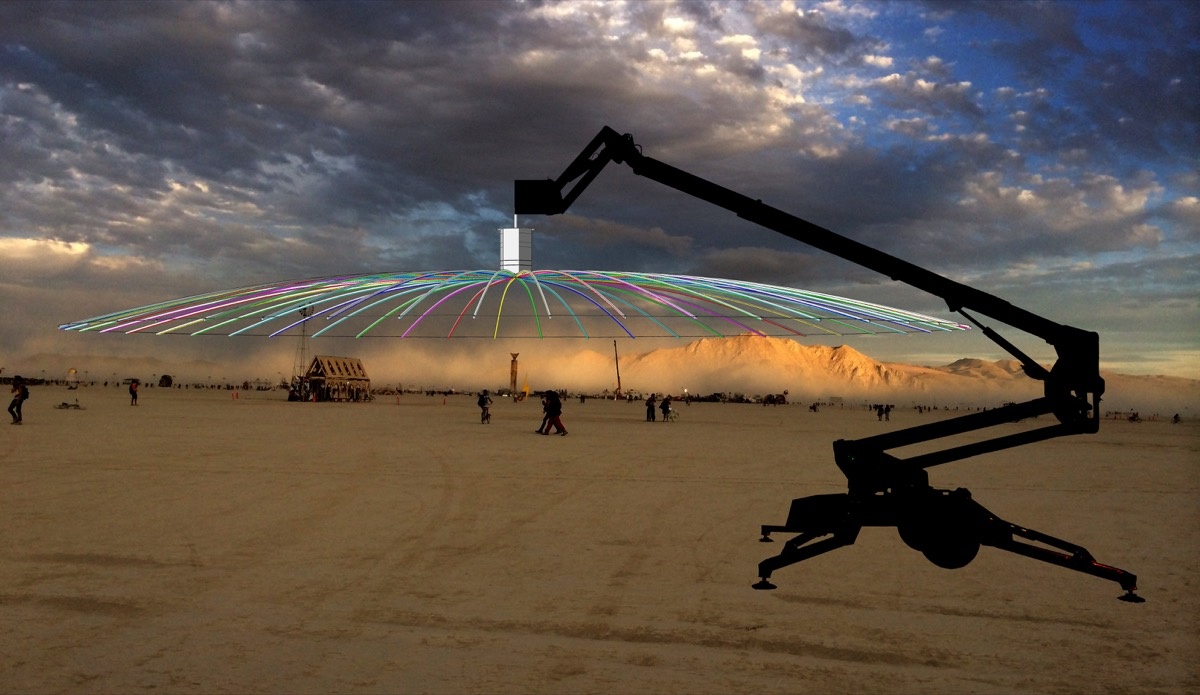
Paraluna
View Slideshow
4 Images
I was inspired to create Paraluna by the success of two other pieces of mine called Firmament and Mesmer. The former created a cozy space where people could enjoy classical music and synchronized LEDs; the latter demonstrated that my LED display technology could be adapted to large persistence of vision (POV) displays. I thought a nice follow-up to Firmament would be something similar using POV.
Paraluna has 48 spokes, each made of aluminum and wood. They mount into a hub of stainless steel and aluminum. The hub contains a 4HP battlebots-type motor that spins the hub and disc. It also contains three Raspberry Pi computers that drive the LEDs. The hub is attached to the tip of a boom lift, like the kind you see raising workers to repair power lines, with the man-platform removed.
What do you hope to communicate through this work?
CS: I hope to create an environment where people can escape the thump-thump of modern Burning Man, a place where they are awed by visuals they’ve never seen before, projected by a machine that truly looks like a robot from another planet.
THE ORB
Bjarke Ingels and Jakob Lange
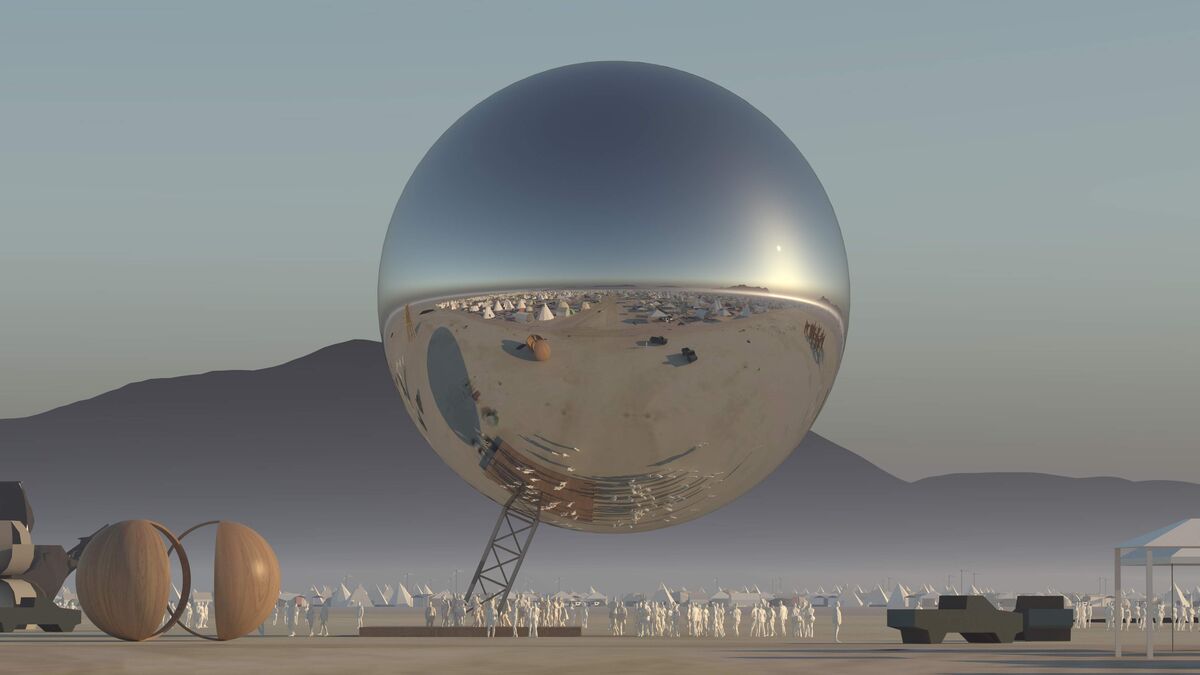
Bjarke Ingels and Jakob Lange, THE ORB, 2018. Courtesy of the artists.
Tell us a little bit about THE ORB.
Bjarke Ingels: THE ORB is our public art piece, a giant reflective artifact 25 meters (roughly 80 feet) in diameter, that we hope to bring to Burning Man and hover above the Playa. Because of THE ORB’s curvature, it will reflect the entire space and people around it, showing the social energy and exchange in an entirely new perspective—essentially turning public life into public artifact!
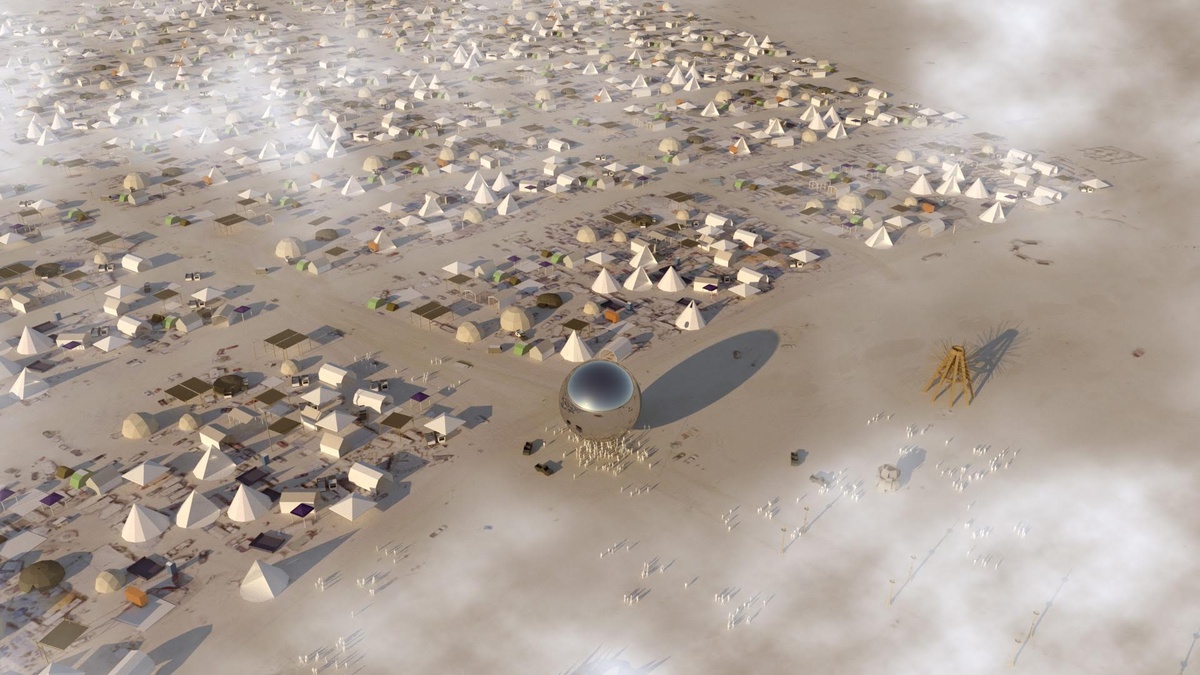
THE ORB
View Slideshow
5 Images
The reflective planet-like sculpture is an inflated spherical mirror, constructed of the same chromatic fabric as NASA weather balloons and supported by a 105-foot (32-meter) inclined steel mast, base plate, and foundation anchors. The team has already invested 30 tons of steel and 1,000-plus welding and sewing hours to make THE ORB a reality; however, we have launched an Indiegogo campaign to crowdfund the final phases of fabricating and shipping the sculpture.
What do you hope to communicate through this work?
BI: THE ORB is a tribute to Mother Earth and human expression, a wayfinder for Burners to navigate the Playa desert, and a celebration of the Burning Man community and creativity. THE ORB sits at the axis of art and utility, and we hope for it to capture the entire Black Rock City in a floating, temporal monument that mirrors the Burning Man experience to the Burners as individuals in the midst of an intentional community.
RadioLumia
FoldHaus Art Collective
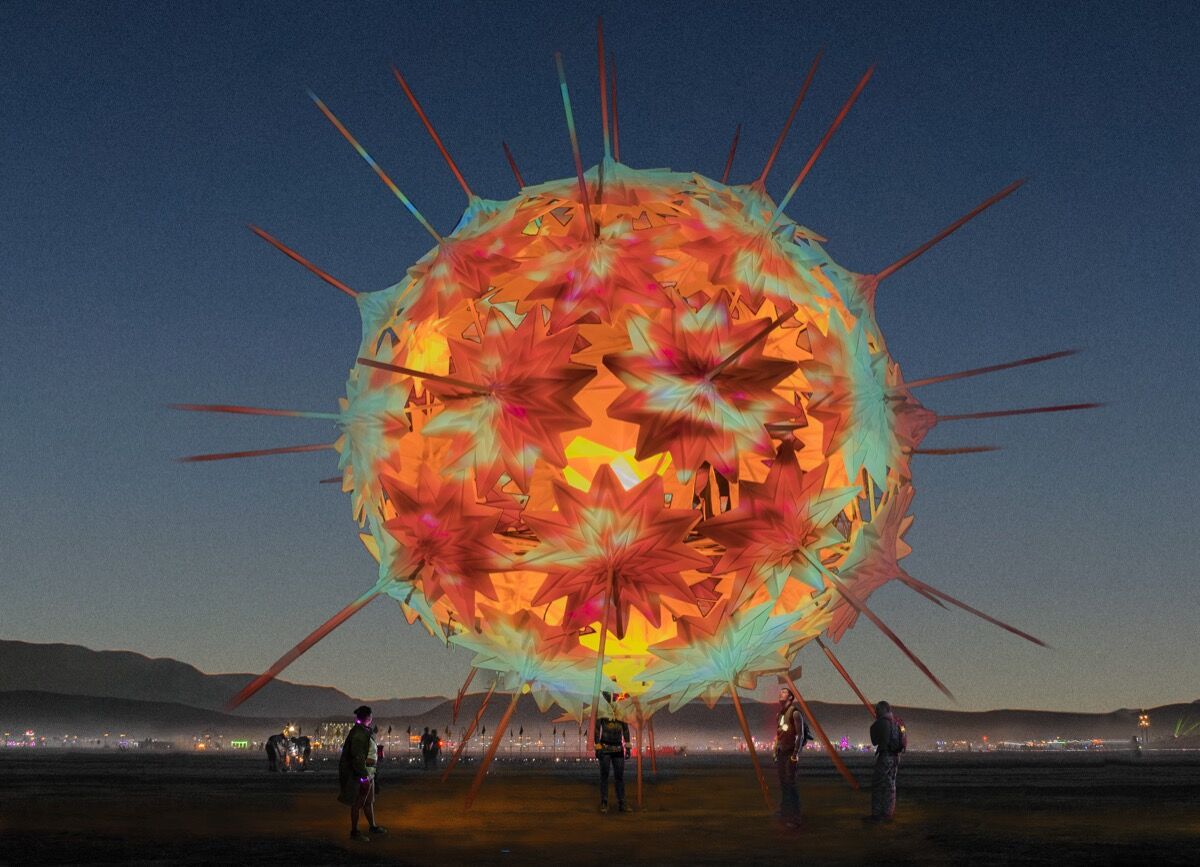
FoldHaus Art Collective, RadioLumia, 2018. Courtesy of the artists.
Tell us a little bit about RadioLumia.
Each installation we create is really an accumulation of all we have learned in the past. Even before our first art installation, Blumen Lumen (2014), we built three shade structures for Burning Man. From early works, we learned how to install in the desert, how to create the mechanics for large-scale origami to be moving, etc. Each year, we increase our ambition.
This year, we’ve designed our most audacious installation ever: RadiaLumiais a 5-story-tall geodesic sphere, covered with a breathing skin of 42 origami shells and radiant spikes. Its shape nods to radiolaria, a tiny protozoa with intricate mineral skeletons that covered the desert thousands of years ago, when it was once the sea floor.
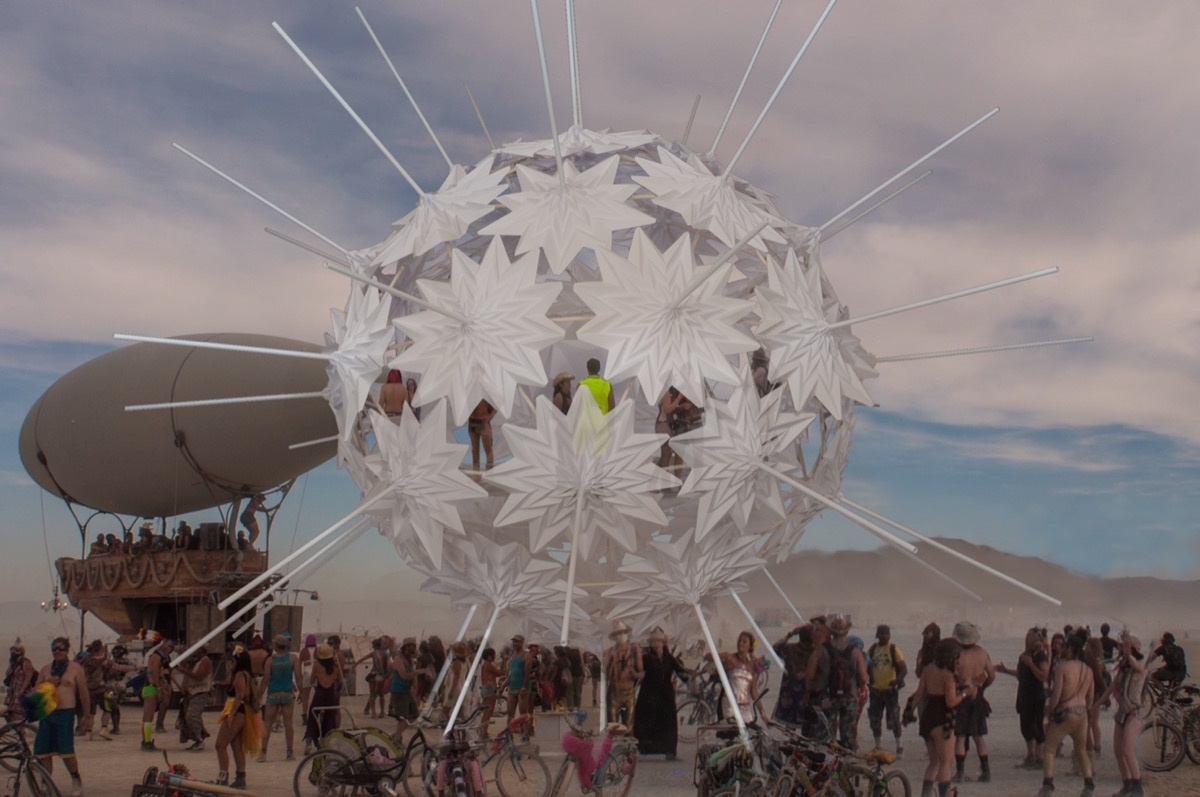
FoldHaus Art Collective
View Slideshow
2 Images
Inside the sphere, a platform will offer a place for visitors to retreat and look out to the surrounding landscape. Like previous installations, RadiaLumiawill have anthropomorphic tendencies, and will delight the audience as it interacts with them. The shells will open and close in response to visitors’ presence, constantly in motion, sometimes protecting the intimate interior of the sphere, sometimes revealing a glimpse of its heart.
What do you hope to communicate through this work?
Honestly, we started building these pieces for the joy of building, and for the increasing technical challenge. Many of us work in design and creative fields, but rarely do we get to build a product entirely with our hands, and for no other reason than for the joy of coming together and building.
What has been an unexpected surprise over the years is the delight we bring others through our work. Much of the team will find themselves sitting for hours by the art at Burning Man, watching visitors’ reactions of awe and glee.
With RadiaLumia, it’s the same: We hope that the hours of community and camaraderie that we have spent building the installation will be embedded in the folds of the origami and will emanate from every movement of the piece, bringing a moment of joy to each and every visitor.
Ichiro Sacred Beings
Marianela Fuentes, Arturo Gonzalez, and Sarahi Carrillo
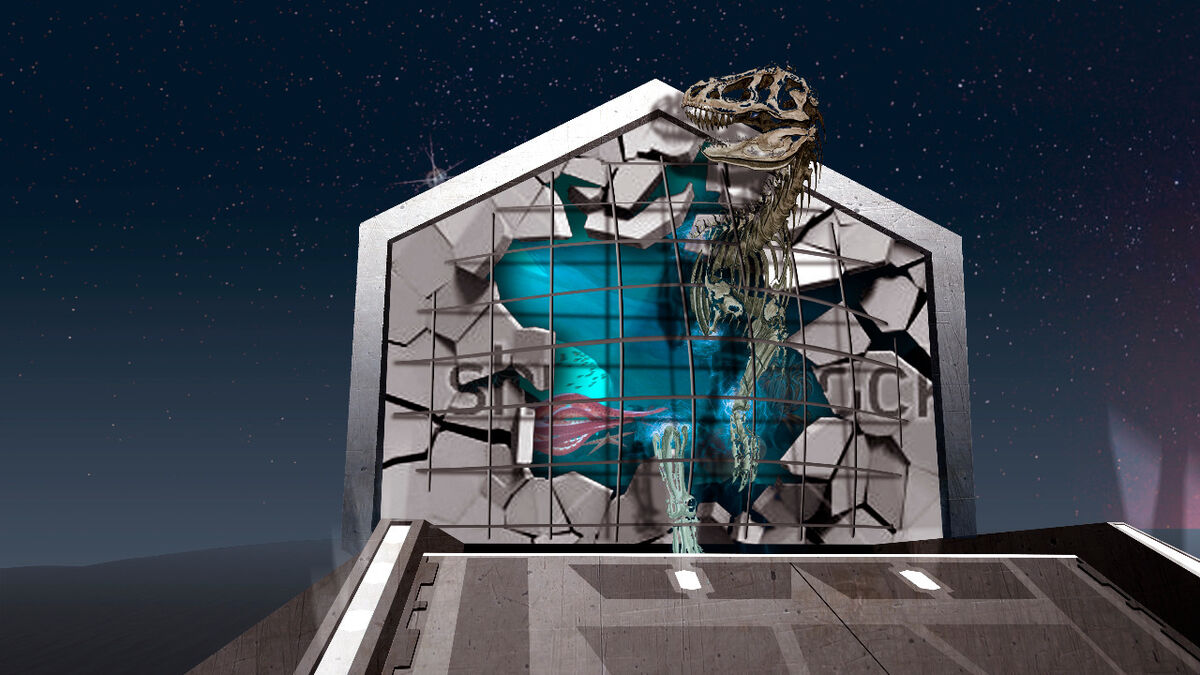
Render of Marianela Fuentes, Arturo Gonzalez and Sarahi Carrillo, Ichiro Sacred Beings, 2018. Courtesy of the artists.
Tell us a little bit about Ichiro Sacred Beings.
Marianela Fuentes: We plan to mount an exact replica skeleton of the Velafrons coahuilensis, a dinosaur from the Cretaceous period, [around] 72 million years ago. The dinosaur will be decorated in the art of the Huichol, an indigenous tribe of Mexico which now lives in the same lands that once were populated by the Velafrons.
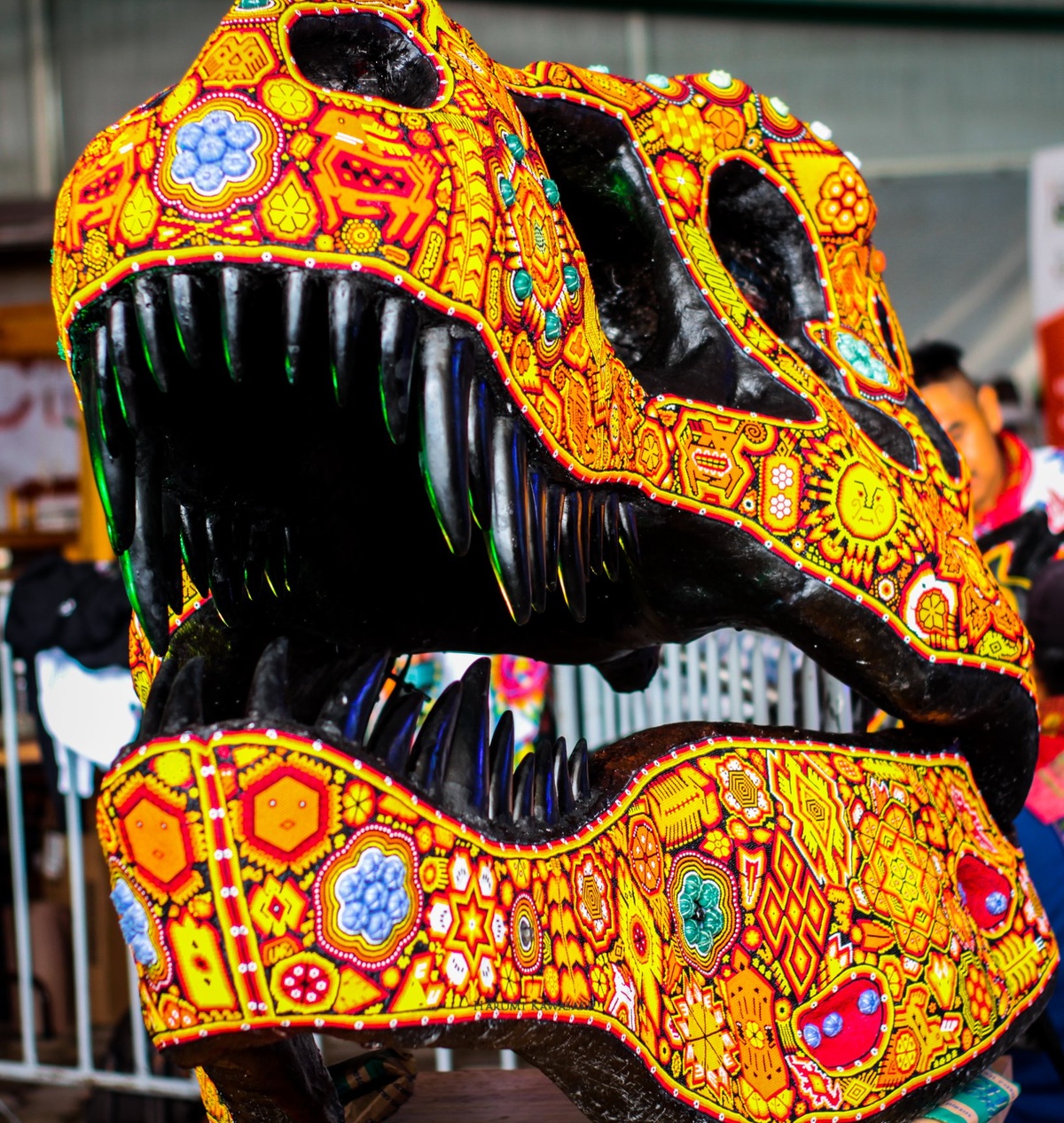
Ichiro Sacred Beings
View Slideshow
4 Images
Next to the Velafrons is the head of a Tyrannosaurus rex, with the same design. These visions also represent the flow of energy that exists within the human body and the universe. The dinosaur will be illuminated from all sides to be visible at night. Ichiro is a very emotional altar of ancient times upon which there will be an original ritual every day at sunset, aiming at connecting with our ancestors and our inner selves.
What do you hope to communicate through this work?
MF: The Huichols (a.k.a. Wixárikas) mainly believe in four deities: corn, eagles, deer, and peyote, all of them descendants of the sun, or “tau.” Annually, they make a pilgrimage to their sacred place where they have a ceremonial center in the Cerro del Quemado, very close to Real de Catorce in San Luis Potosí. Then they perform religious rituals and talk to the divinity. They have their own, very different worldview, as well as ancestral wisdom that is still passed on from generation to generation orally.
The Huichols travel through Mexican deserts to do this, and in the desert of Coahuila in 1995, the desert museum discovered, among many other asanas, the bones of Velafrons coahuilensis. And so, connecting points, we knew that by giving life to the replica of that dinosaur, covering it with the art of a magical and ancestral culture such as the Huichols, and accompanying the powerful T. rex, we could generate an installation that transcended the limits of only aesthetics and beauty. Designing a base and structure that emanates the portal from which the past awakens, we would generate a lot of value for those around this piece.
Singularity
Rebekah Waites and the Singularity crew
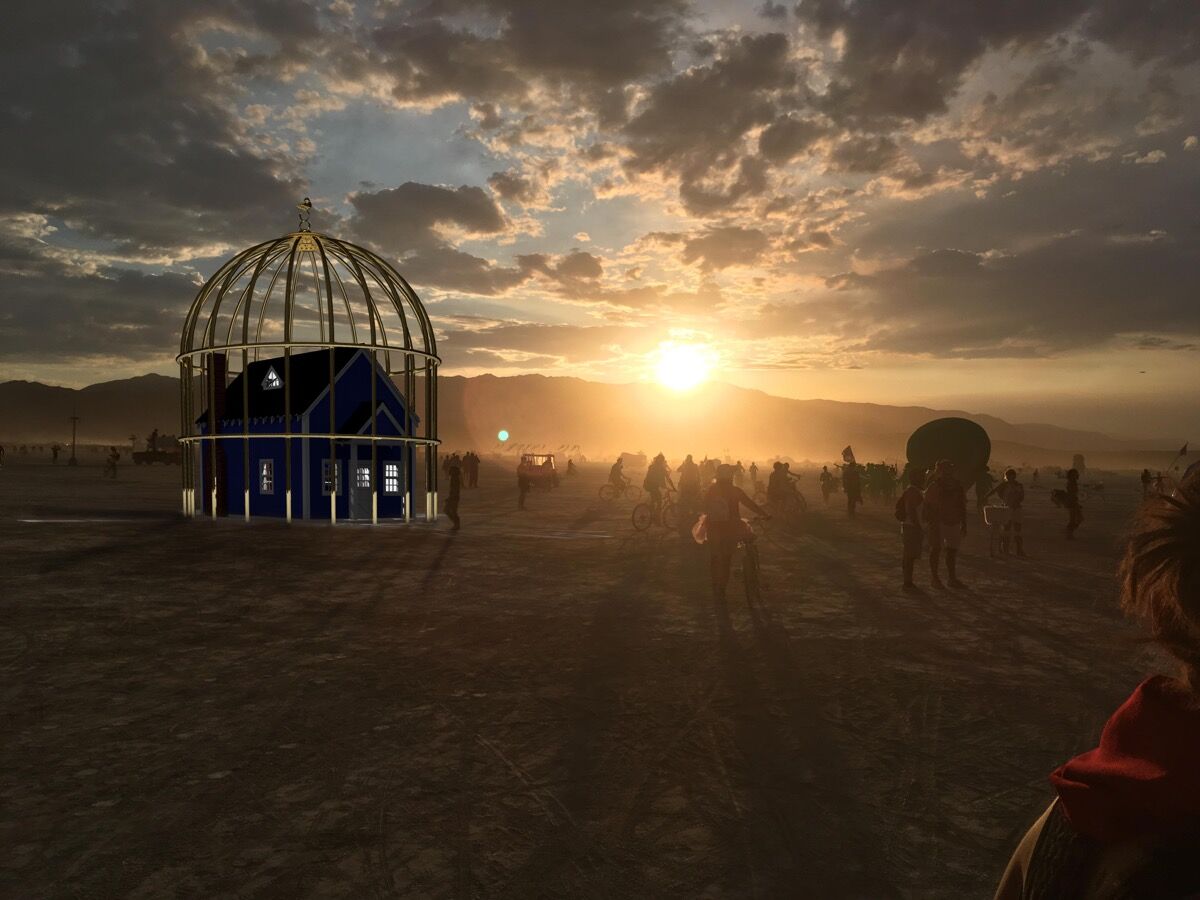
Rebekah Waites and the Singularity Crew, Singularity, 2018. Courtesy of the artists.
Tell us a little bit about Singularity.
Rebekah Waites: Singularity is my second large-scale art piece, and the second piece of my “Trap” series. In 2013, I created a piece called Church Trap, which playfully explored how dogma and religion can be a trap. This second piece, Singularity, uses physics to explore psychology. It is about how we create mental traps in our brains.
What do you hope to communicate through this work?
RW: While in therapy for a really bad chronic depression episode, I became fascinated with how traumatic events in my childhood shaped me as an adult. I’ve always been fascinated with astronomy and black holes. I came to the conclusion one day that my brain was essentially acting as a point of singularity and replaying repetitive childhood memories on an infinite loop.
Each layer of Singularity represents a memory of a memory, shrinking down to an infinite point. The idea of Singularity, with its multiple layers of birdcages and trapped houses, represents how we trap memories. For me, the escape from my birdcage was hitting rock bottom and digging my way out by creating this piece. I hope this piece inspires others struggling with depression to do the same.
Let U.S. Prey
Mr and Mrs Ferguson
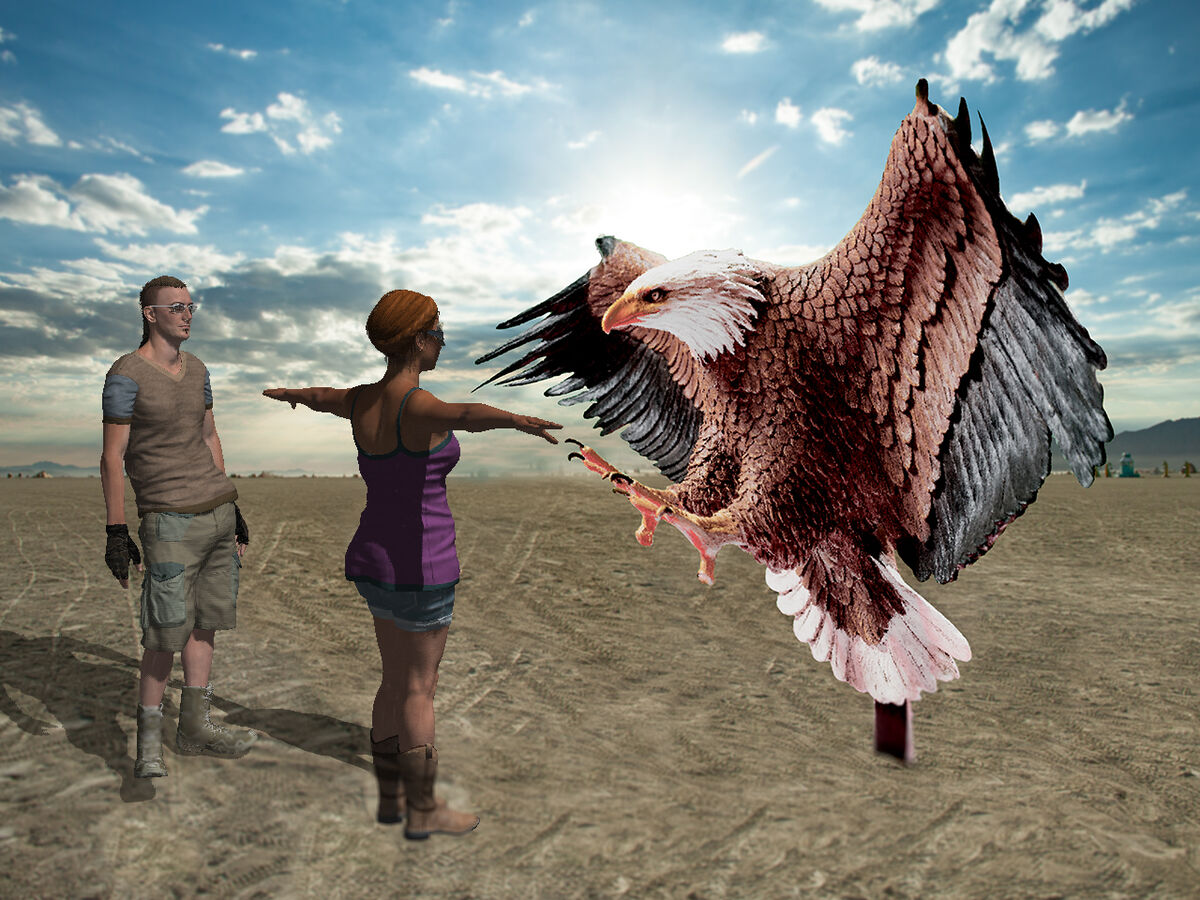
Mr & Mrs Ferguson, Let U.S. Prey, 2018. Courtesy of the artists.
Tell us a little bit about Let U.S. Prey.
This bald eagle is about to strike. Its piercing gaze staring straight into your eyes. Its talons reaching for your chest. You are in the final moment before you become prey.
The eagle is regarded as one of the greatest of hunters, and because of its ability and nobility, it is often co-opted as a metaphor for freedom, political values, gun rights, militarism, and religious piety. It’s a metaphor that you may have issues or concerns with.
For 2018, Mr & Mrs Ferguson will be bringing a bald eagle with a 15-foot-wide wingspan to the Black Rock Desert. As we had created with our previous project Penny the Goose, we will use the common penny to create the effect of feathers. In addition, this year, we are adding nickels and dimes, which will create the illusion of white feathers on the eagle’s head and tail.
What do you hope to communicate through this work?
Our goal is to make interactive art that draws a person in by deception. From afar, our pieces look like painted or steel, but upon inspection, you see that it is a collage of coins that feel captivating to touch. People laugh or are amazed. They spend time with the art.
There is a political component to this art, but perhaps not everyone will think that. They don’t have to, either. It’s their experience.
Myriapoda Robota
Art To Be Continued… Collective
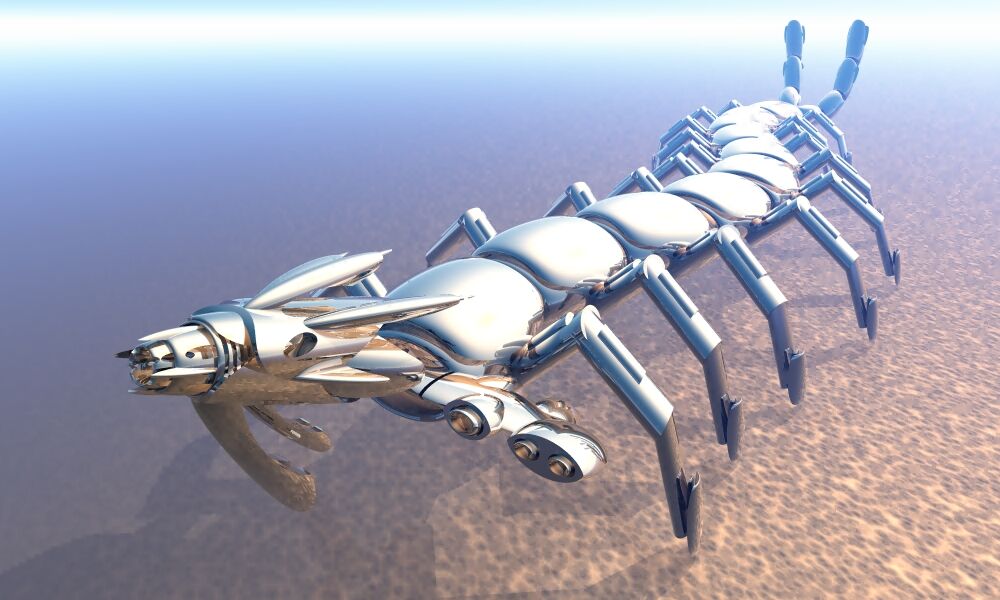
Render of Art To Be Continued Collective, Myriapoda Robota, 2018. Courtesy of the artists.
Tell us a little bit about Myriapoda Robota.
Myriapoda Robota, a 30-foot-long mechanical centipede from the future, is constructed of reclaimed aluminum and wheelchair components. Motors propel the eight bodily segments along a spine of gear boxes and drive shafts. The walking mechanism, initially designed to draw a steam piston in a straight line, reduces the seemingly sophisticated movements of insects into gearing and clockwork.
Lost on the Playa, Myriapoda’s lights are dim and her movements slow. Proximity sensors alert her emotional logic to the presence of other life, and over the course of the week, through the culmination of interactions, her emotional state improves, her movements speed up, and Myriapoda finds home on the Playa.
What do you hope to communicate through this work?
Several metaphors have emerged throughout the planning and construction of the project. Myriapoda is a mechanical centipede, perhaps a replacement for biological insects after our planet’s environment has been irreversibly altered.
Despite being comprised of metal and gears, Myriapoda still yearns for connection and belonging, and finds this through the interactions with the citizens of Black Rock City. This parallels the lead artist David Date’s experience on the Playa in confronting his anxiety-related depression. Myriapoda’s journey can also be applied to psychedelic harm-reduction practices, in that our negative thoughts and emotions can be moved towards understanding and growth under the compassion and care of others.
Long View
Don Kennell and Arctic Burn 505
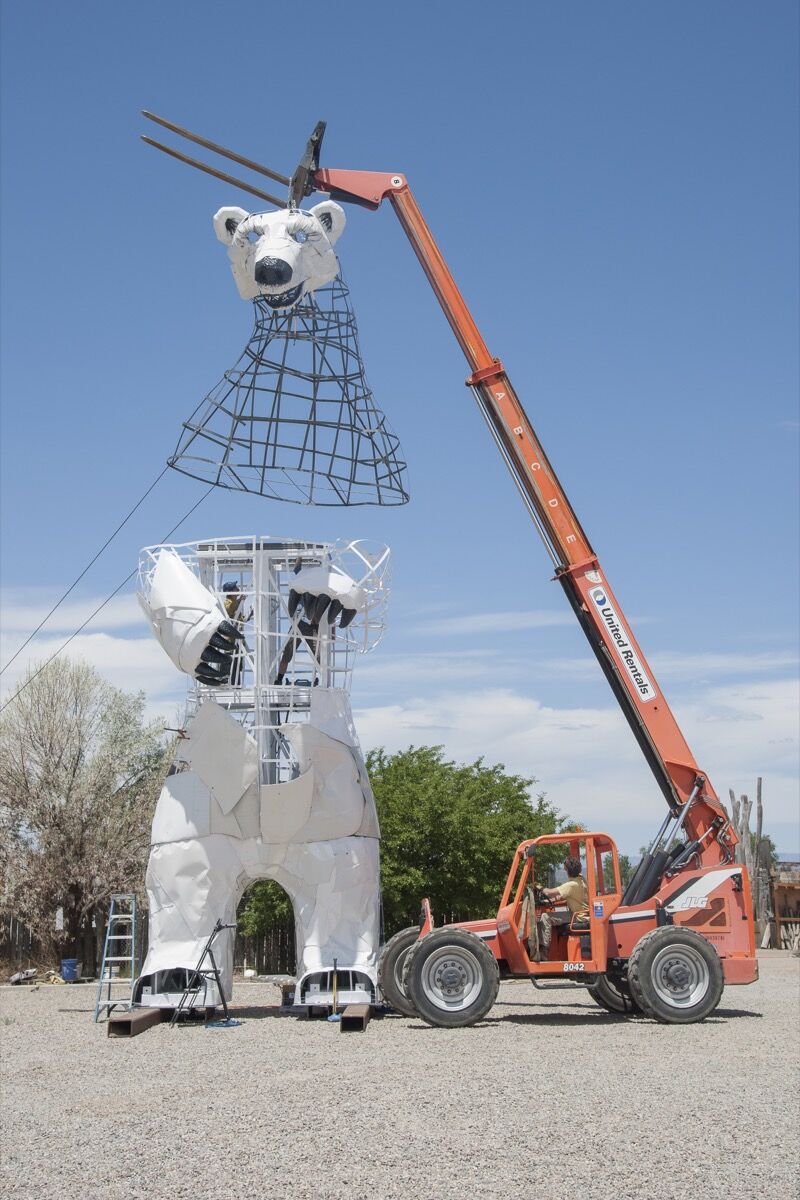
Progress image of Don Kennell and Arctic Burn 505, Long View, 2018. Courtesy of the artists.
Tell us a little bit about Long View.
We are building a polar bear out of car hoods to show the connection between carbon footprint and habitat loss.
We will create the armature for the sculpture using structural steel tubing, and use steel strap to create the forms of the bear. We salvaged over 100 white car hoods from local junkyards. These are bolted on to the steel strap to complete the artwork. The sculpture comes apart into eight sections and will arrive on two semi trucks. It is built like a steel tower using a forklift with the pieces being bolted together. At night, images of ice and sea life are projected onto the white car hood surface.
What do you hope to communicate through this work?
The polar bear is depicted standing. The title of the piece, Long View, is a term used to describe polar bear behavior in the wild. Polar bears stand up to look out across the vast distances that surround them. We believe animals have a message. The polar bear’s message is to take the long view. We are making this artwork so people can hear the polar bear’s message.
Polar bears help humans imagine a faraway place. They are uniquely positioned as ambassadors to bring the arctic into human awareness. Combining content and joy, we ask the viewer to develop a relationship with the animal. Animals disappear to make room for our cars. Turning wrecked cars into monumental animals visually reverses this process.
iSheep
Bardia Saeedi and regional artists in Washington, D.C.

Bardia Saeedi, DC Regional Artists, iSheep, 2018. Courtesy of the artists.
Tell us a little bit about iSheep.
iSheep is a flock of robotic sheep roaming the Playa in search of company, fun, and joy. They each have a distinct personality and voice, and are going to the Playa to party with the Black Rock City residents. Although they do like to gift bareback rides, like any other gift bearer on the Playa, they like to offer their gifts respectfully and with mutual consent. Approach them, gently pet them, and maybe they will be in the mood to give you a ride.
The inspiration for this work came in a flash when the artist heard about this year’s theme of “I, Robot.” Immediately after that, the theme of consent presented itself. iSheep, like most of the artist’s previous installations, is a participatory project. A team of more than 20 volunteers has made this project happen, and most of them had complete freedom in their artistic creativity. The fabrication technique took a few twists and turns before it was finalized. The electronics and software are the brainchild of one dedicated team member producing 13 sheep brains.
What do you hope to communicate through this work?
We have already seen the reactions of people when they interact with the piece. This project, though touching on sensitive subjects, is all about smiles and laughter when first encountered, interacted with, ridden, raced, bumped, and spun all over the Playa. We have designed this piece to be interacted with in the harsh conditions of the Playa, as well as the harsher conditions of hard play. People will play, but in the back of their minds, the thing that will hopefully stay is that the sheep were fun, but they also had a message: Show respect, ask for consent, and then play hard.
Passage Home
Kate Raudenbush

Kate Raudenbush, Passage Home, 2018. Courtesy of the artist.
Tell us a little bit about Passage Home.
Kate Raudenbush: In resonance with the profound loss of Burning Man founder Larry Harvey in April, I feel compelled and inspired to create this sculpture to honor his extraordinary life.
Passage Home hopes to evoke a symbolic homecoming of Larry’s spirit back to the Black Rock Desert. Five white pentagonal doorways recede in space to the horizon in alignment with the sunrise. The patterns filling each pentagon are the radial streets of Black Rock City, with a keyhole-shaped opening to walk through that changes with each doorway passed.
The sculptures are meant to be discovered far from the main city streets, in the quiet, contemplative, open space of the deep Playa. It will be softly illuminated at night with a halo ring of amber light. When approached at dawn, each of the doorways will lead the viewer towards the rising sun, and slowly, through subtly morphing keyhole openings framed by the map of our city, bring us to the silhouette of Larry Harvey, wearing his signature Stetson hat, walking into the sunrise.
What do you hope to communicate through this work?
KR: What I loved so much about Larry was that, despite his vast intellect, Burning Man was never about him; it was about the container of possibility that he shaped and held sacred. He was a brilliant conduit of energy, and he asked us to fill it with our creativity; and that, in turn, created an evolution of culture beyond all of our wildest imaginings. Passage Home is a symbolic conduit that is filled with symbols of what Larry created. Out in the desert there is nothing, but together we build a city, a culture, and unlock parts of ourselves we never knew existed; all because of this instigator, chief philosophic officer, mentor, and friend.
Cosmic Voyager
Martin Taylor and Chromaforms

Render view of Martin Taylor and The Chromaforms Collective, Cosmic Voyager, 2018. Courtesy of the artist.
Tell us a little bit about Cosmic Voyager.
Martin Taylor: Cosmic Voyager is constructed from laser-cut polished stainless steel bent into a polygonal swimming sea turtle. A futuristic city rises from within the turtle’s body into an acrylic skylight dome above. Participants can walk underneath this majestic spaceship-like creature and peer upwards into the city within.
The piece was inspired by the work of famous futurists Gene Roddenberry (creator of Star Trek, which spawned a successor, Star Trek: Voyager) and Buckminster Fuller. Cosmic Voyager combines the ancient mytheme of the “cosmic turtle” carrying the world on its back, with reflective futuristic design reminiscent of a “spaceship Earth” traveling through the dark abyss of deep playa space. Buttons on the turtle’s fins allow participants to receive a recorded horoscope reading that changes based on the date and time.
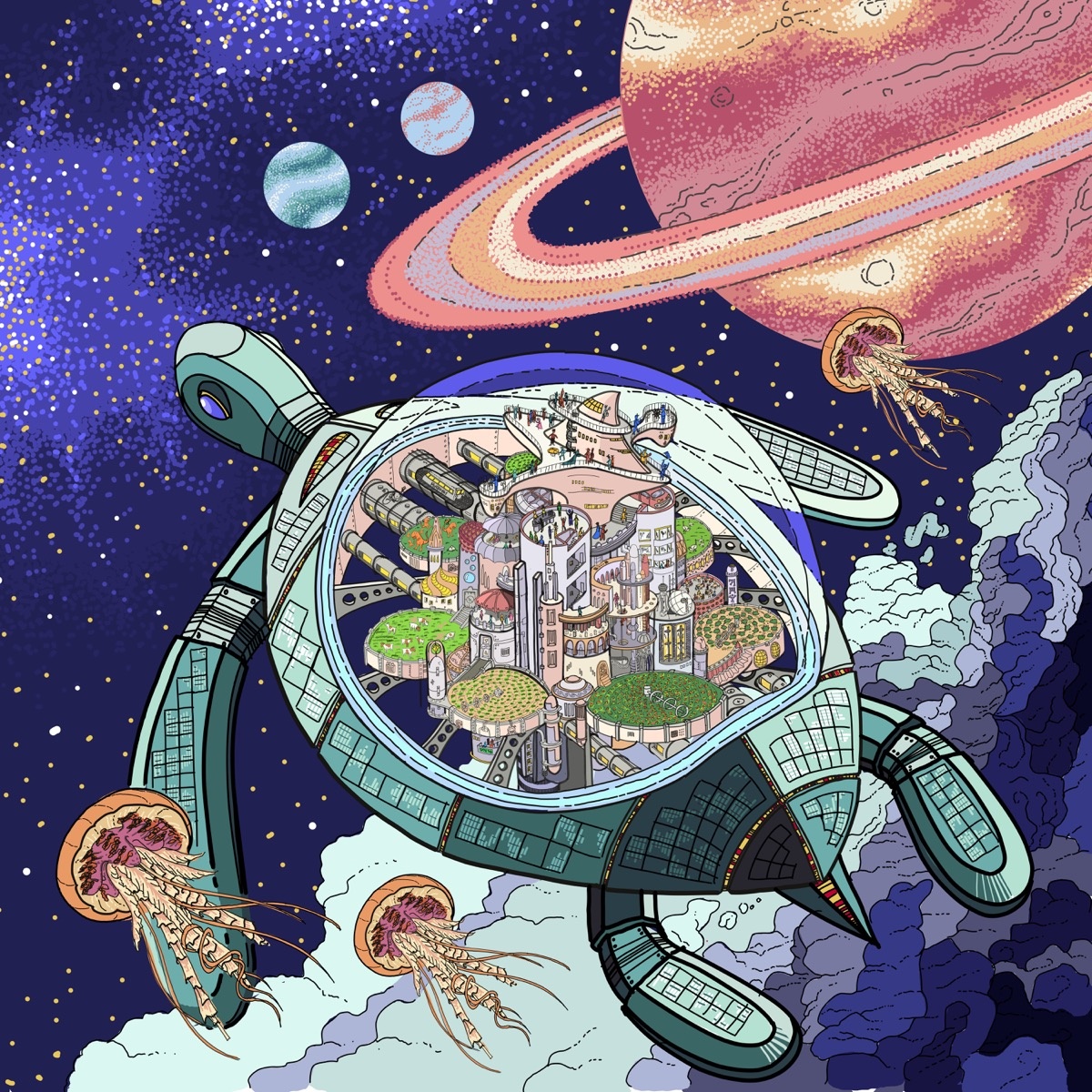
Cosmic Voyager
View Slideshow
4 Images
I brought together a diverse group of artists and designers to create this spacecraft. My friend Colin Bowring, a former 3D animation instructor, modeled the turtle’s form. The futuristic world contained under the turtle’s dome was designed by architect Jamie Marchini and animator Conor Molinare, who were inspired by the traveling temporary architecture of the hippie movement. The horoscope system was designed by electrical engineer and hacker John Fitz, with horoscopes by astrologer and editor Leah Markman, which were recorded by singer-songwriter Amy Edwards. I designed and fabricated the steel structural frame that will support the 1,500-pound turtle and used parametric design software and my knowledge of origami to create the laser-cut stainless steel plates.
What do you hope to communicate through this work?
MT: I grew up in Silicon Valley and have been involved in the creation of all sorts of new technology, including solar-powered electric cars, consumer products, and robots. I was worried that many participants would interpret the “I, Robot” Burning Man theme negatively; humans have a general distrust for robots. As a technologist, I’m very optimistic about the future and feel that I have the power to shape it in a positive direction. It would seem that modern society, as evidenced by the litany of dystopian science fiction movies being created, does not share my optimism.
With Cosmic Voyager, I wanted to bring the old and the new together and encourage people to think positively about what sort of future we want to create.
Robot Resurrection
Shane Evans and Robot Crisis Unit
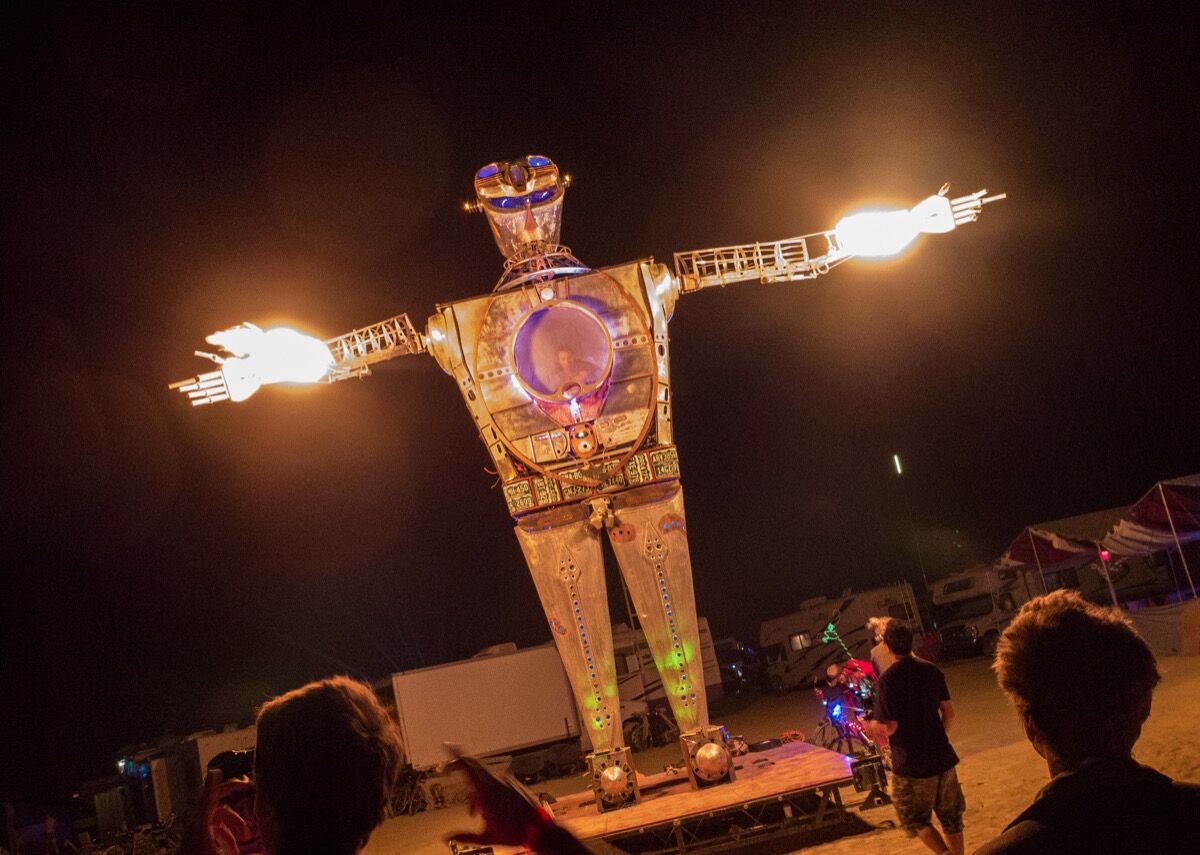
Shane Evans, Robot Resurrection, 2014. Photo by Todd Powell. Courtesy of the artist.
Tell us a little bit about Robot Resurrection.
Shane Evans: It all started when I lived in Brooklyn; people just put their trash out on the street and I started picking up pieces and I built my first robot, which was about 9 feet tall. Originally, I was going to put it back on the street, kind of as graffiti, but it turned out so cool, I just couldn’t give it up.
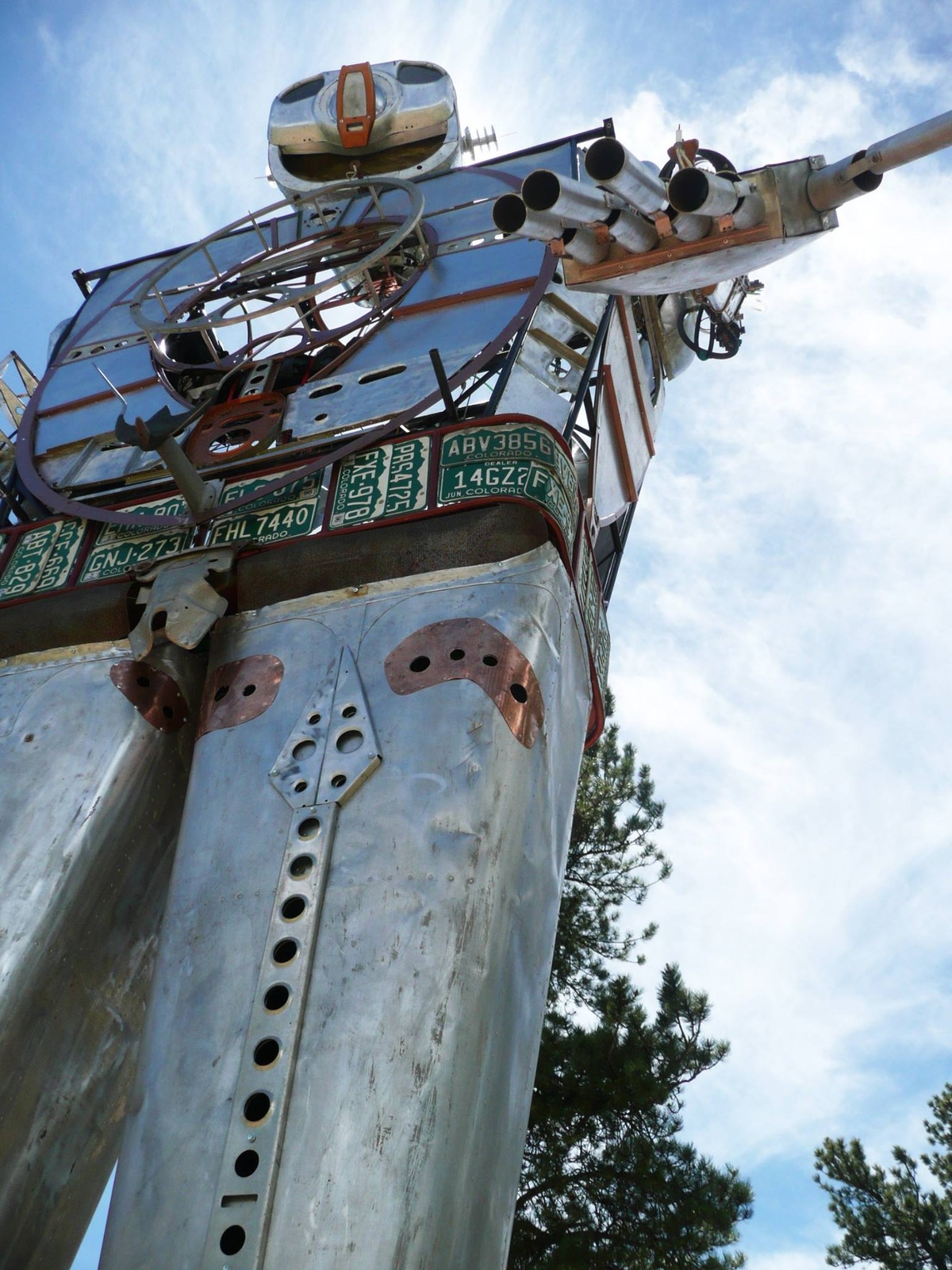
2 Images
View Slideshow
I’ve always been metal-sculpting, and then I did a whole series of little small ones. And out at Burn one year, I thought: “You know, I should just do a giant one, climb inside of it, be able to operate it in the chest, and be able to drive it around Burning Man.” So I went to an airplane junkyard and hand-picked a bunch of pieces that I thought that would look good together, and started building it in 2014.
This year, I’m bringing two robots: Big Charles, which is pretty much all fire, it doesn’t move; and Robot Resurrection, which is 28 feet tall. It articulates and has six different fire effects on it.
What do you hope to communicate through this work?
SE: It’s all made from recycled objects that people discard, so it’s drawing attention to how we live in this disposable world and we just constantly throw everything away, without trying to repair it. And very few people upcycle. It’s to raise awareness of what we’re doing with our planet, destroying it with all of this trash and wastefulness.
Franchise Freedom
Studio Drift
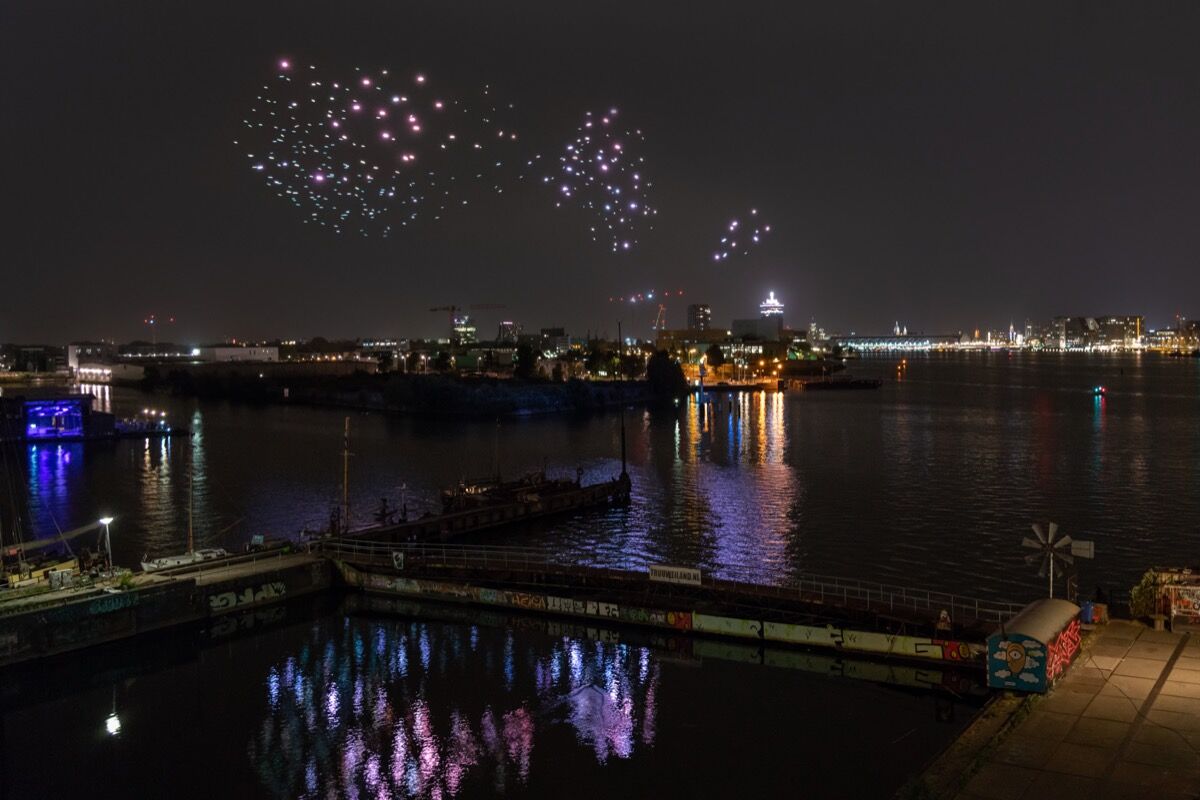
Studio Drift, Franchise Freedom, 2018. © Ossip. Courtesy of the artists.
Tell us a little bit about Franchise Freedom.
Ralph Nauta: The piece basically started 10 years ago with a work called Flylight (it can be seen in the Stedelijk Museum in Amsterdam where currently we have a Studio Drift retrospective, “Coded Nature”), where we started talking about the boundaries and illusions of freedom. When you’re looking at swarm behavior among birds, you think you’re looking at the ultimate free, natural performance, but it’s all bound to specific scientific and social rules for how the individuals function within the group. So, looking closer, there’s absolutely no freedom. It’s the same as humans in our society: We have this mission or goal that we strive to, that we think will give us freedom, and in the end, it’s an illusion. We always have to adjust to these rules that tell us how to function. This is beautifully visualized in these swarm behaviors.
The artwork will be a performance of 600 or 1,000 drones, and we will use the computer program we’ve created that is intended to fly the Franchise Freedom swarm around the world. Everywhere we would like to fly it, though, it’s different, because it adapts to its surroundings. That means it has to fly in certain parameters, and there are different kinds of winds we have to take into account, but there are also natural influences.
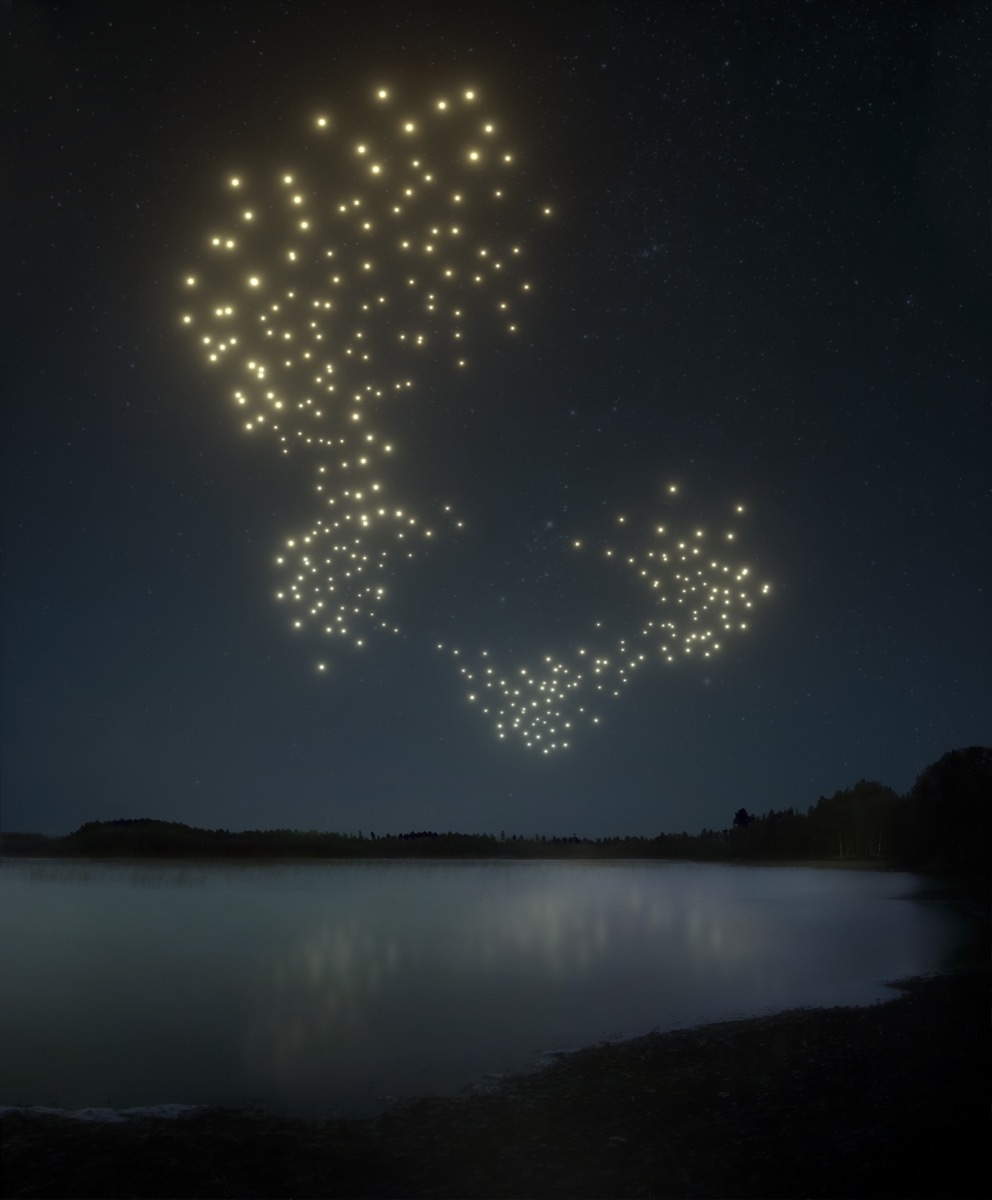
4 Images
View Slideshow
In 2007, for Flylight, the basis of this work, we created an algorithm of swarm behavior. We have been working for 10 years on Franchise Freedom to get the swarm behavior to the next step and actually fly it in a three-dimensional environment. We’ve traveled the world to top universities and scientists who have done a lot of research over the years on swarm behavior, then we translated that into our computer program. From there, we adjusted it; it wasn’t quite right yet. We kept studying and learning about these swarms and the inputs they get from their surroundings, then revisited the science behind the piece with own research.
What do you hope to communicate through this work?
RN: We’re trying to raise questions of where you want to be as a human: Do you want to be outside the fence or inside the fence? Free or protected? Are you going to be outside, completely alone and vulnerable with the dangers for survival? Or are you going to be inside the fence, where everything is cozy, it doesn’t take a lot of effort to live, but you have to give away your freedom? We wanted to create something that questions how we behave.
We truly believe it is important to create technology for poetic and human-centered purposes. We want to show technologists the social value their creations can have—ways to use technology with humanistic thinking that will benefit our society. This is the role that we, as artists, want to fulfill. I hope that people see that in the work.
Rayactivation
Douglas Ruuska and Divide By Zero Labs
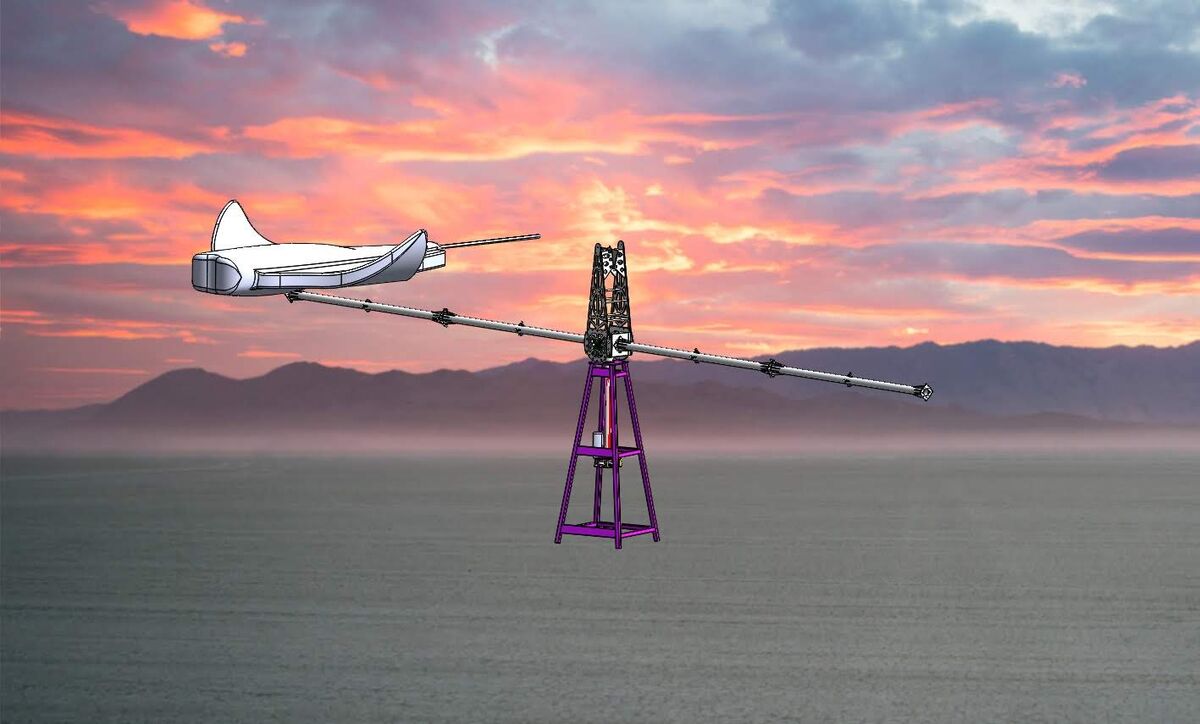
Render view of Douglas Ruuska and Divide By Zero Labs, Rayactivation, 2018. Courtesy of the artists.
Tell us a little bit about Rayactivation.
Rayactivation is a giant, interactive, illuminated manta ray that will fly over the heads of Black Rock City citizens as it swims across the night sky. Think of it as a manta ray automaton; specifically, a moving mechanical device made in imitation of a cownose ray (Rhinoptera bonasus). It’s fabricated primarily from aluminum, 7,000 LED lights, and a layered spandex skin.
With a 20-foot wingspan, it will cruise the sky 14 feet above the Playa, flapping its wings, in a 40-foot-diameter circle. It is supported by a lightweight aluminum frame, so the entire creature only weighs about 400 pounds. The manta ray’s LEDs will glow and pulsate in response to people and light; real manta rays change color via chromophores in their skin.
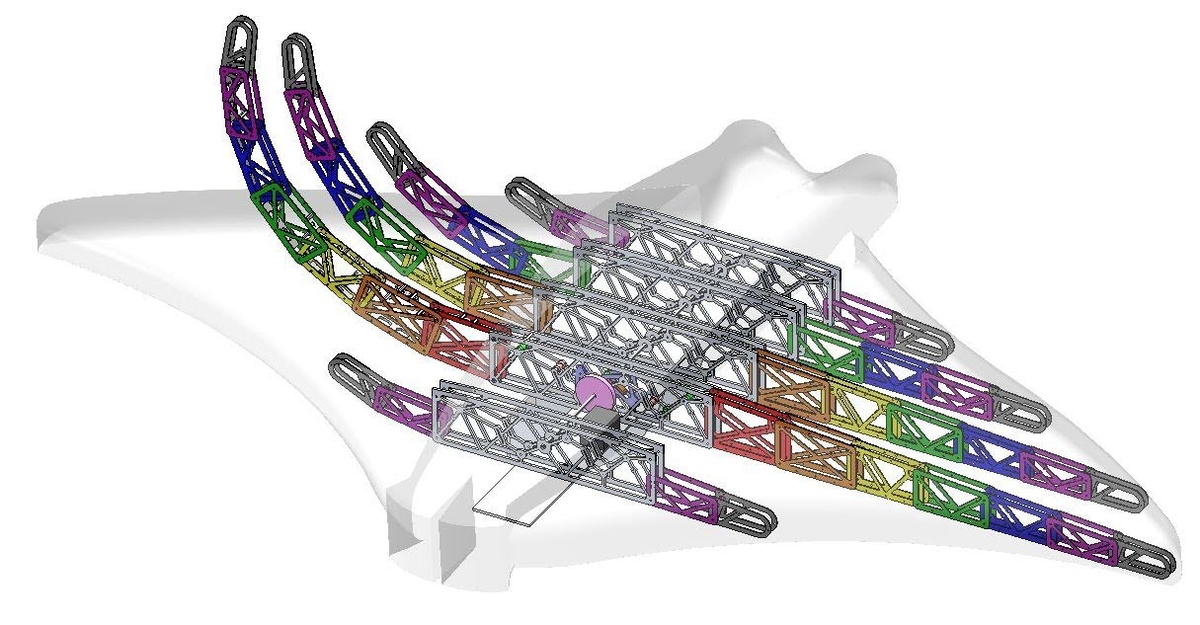
3 Images
View Slideshow
What do you hope to communicate through this work?
One thing that art can do is bring magic to life. We do not expect to see magic everyday. The ability to realize, in some fashion, the common fantasy of flying creatures—be it us or other flightless life-forms—is something that I wanted to play with building Rayactivation. This piece, a large ray of light flying overhead, between us and the stars, encourages us to contemplate that freedom of being untethered from the Earth.
Second, we can demonstrate the connectedness of the planet as a whole. Just because something is normally out of sight does not mean that it is not there. Bringing creatures normally hidden out into the light is an important part of exploration. Black Rock City exists in the dry lakebed (also known as “playa”) of the prehistoric Lake Lahontan. Rayactivation swims through the sky in reference to the ocean of air above the land.
Lastly, Rayactivation invites citizens to be part of the art. Participants’ very presence changes the chromophoric light pattern in noticeable ways. Some folks will spend the time necessary to figure out the interaction methodology that we used and ultimately solve the puzzle. These individuals transform from observers to integral components of the artwork directing the light patterns.

Comments
Post a Comment